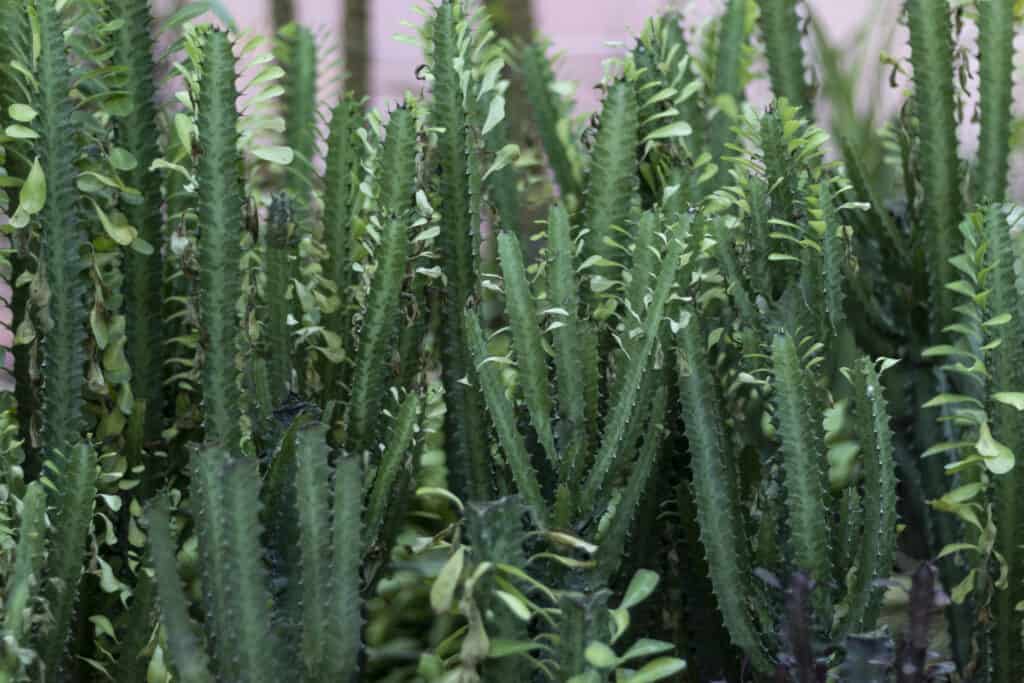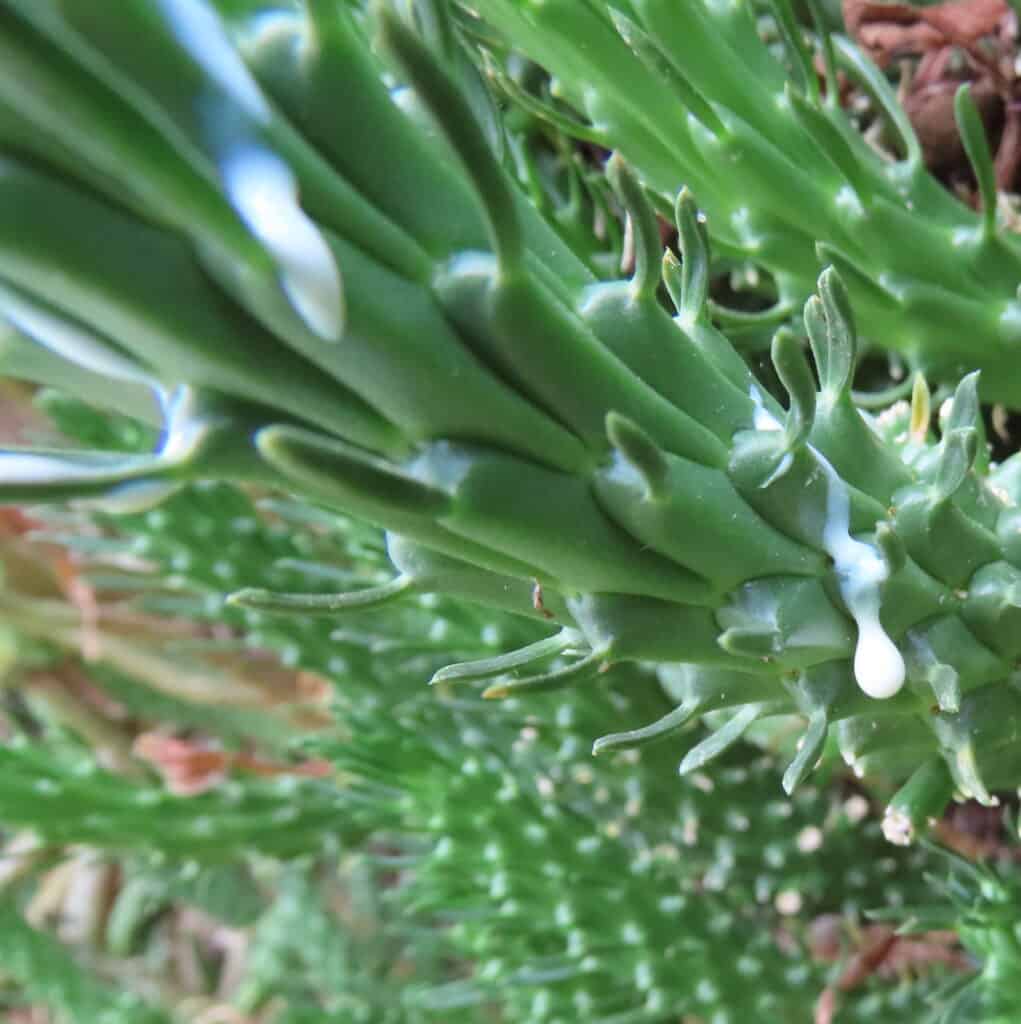Euphorbia vs. cactus can look very similar in the garden and it’s difficult to tell them apart. Let’s take a closer look at these two plants to see what the differences are, because once you get past the thick leaves and sharp bits you’ll see they are quite different plants altogether.
Key Differences Between Euphorbia vs. Cactus
Euphorbia and cactus are both succulents with moisture-retentive foliage and the ability to cope with drought, but they have many differences.
The main variations are that euphorbia plants have obvious separate leaves, they leak toxic milky sap from broken stems, and they have small flowers compared to their overall size. Cactus plants have spines, areoles, and no obvious separate foliage from the root or clump.
A simple way to tell the difference is to look at the sharp bits (if there are any). Cacti have needle-like spines growing from areoles whereas euphorbias have thorns growing on branches.
| Name | Euphorbia | Cactus |
| Native range | Most of the Old World, especially Africa | South and southern North America |
| Foliage | Moisture-retentive tough leaves in a variety of colors | No obvious leaves, but short areoles that produce spines and flowers |
| Flowers | Small clusters, usually yellow but sometimes pale green, pink, cream or red | Waterlily shaped jewel tones that persist a day or two |
| Growing Zone | 4 -11 depending on the species | 4-11 depending on the species |
| Toxicity | Toxic irritating sap, toxic seeds | Toxic if eaten |
What Is Cactus
Cactus plants (cacti or cactuses plural) sit in the Cactaceae family of the Caryophyllales order. There are 127 cacti native to South America and southern areas of North America.
Cacti are succulent plants which means they conserve water inside their thick fleshy bodies. Many cacti live in desert environments and they are one of the few species that can cope with the Atacama, a vast desert and one of the driest places on our planet. They also grow in mountains and some are tree-dwelling epiphytes.
The name cactus is derived from the ancient Greek word Kaktos which means a spiny plant.

Many cacti live in desert environments.
©iStock.com/ETIENJones
What Is Euphorbia?
Euphorbia is a genus of over 2000 plants in the Euphorbiaceae family. Euphorbia are often called spurge and there are many different types of annual, biennial, and perennial plants from trees to the smallest border filler. Spurge varieties live in most climates except frozen lands and it’s one of the largest genus of flowering plants.
Euphorbias are native to most of the Old World, but especially Africa, and were named after the ancient Greek physician Euphobos who wrote about their use as a strong laxative.
Euphorbia vs. cactus are often mixed up. In particular, euphorbias from Africa and Madagascar have developed foliage that resembles cacti, but there are some simple ways to tell them apart.
Growing Zones for Euphorbia and Cactus
There isn’t one growing Zone for euphorbia because the plant range is so large. Some are capable of tolerating Zone 4, but the majority suit Zones 9 and above. Some can be evergreen in southerly Zones.
It’s almost the same for cacti. Many are cold hardy down to Zone 4, but the majority need Zones 6 and above. It all depends on the species.
Euphorbia vs. Cactus: Foliage Differences
The most obvious difference between euphorbia and cactus is the milky sap that leaks from broken euphorbia stems. Cacti don’t have milky sap. Wear gloves if you break a piece off, because the sap is highly irritating to the skin.
The majority of cacti have spines, depending on the type, and these spines are modified leaves. Some are soft and woolly but they all emerge from areoles. Only cacti have areoles and they are designed to produce both spines and flowers. They are simply very short shoots and branches that have developed in a small and hard form to conserve moisture. Not all cacti will produce spines but they will have areoles.
Euphorbia foliage varies depending on the species, it can be narrow, linear and lime green through to brightly colored rosettes in orange and red. Their foliage is generally quite thick and rough which is similar to some cacti varieties.
Euphorbias don’t have spikes, but some have thorns that make a V shape.

Euphorbia foliage is generally quite thick and rough. While they don’t have spikes, some have thorns that make a V shape.
©iStock.com/Bilal photos
Do All Euphorbias Have Spines?
If you were wondering what the difference is between spines and thorns, it’s quite simple. Spines are leaves and thorns are branches!
Cacti grow spines from their areoles whereas euphorbia grows thorns on their stems. Not all species have spines or thorns, the genera are so large there are many different plants with differing habits.
Euphorbia vs. Cactus: Flowers
Both euphorbia vs. cactus have flowers that are pollinated by insects, bats, and birds, but in some countries euphorbia species are pollinated by lizards!
One of the main differences is euphorbias have flowers that are very small compared to their stems and foliage plus their colors are usually shades of yellow, but they may be red, cream, pink or pale green too. Their actual flowers are miniature and surrounded by protective bracts that last for several weeks, if not months.
Euphorbia flowers mature into round, pumpkin, or knobbly seeds.
In contrast, cacti flowers usually only last a few days and are dazzlingly bright jewel colors in waterlily form, when their seeds develop they are smooth spheres or ovals.
Are Euphorbia vs. Cactus Toxic?
Euphorbias and their cultivars are toxic, including pencil cactus (yes, this is a euphorbia, I know it’s confusing!) and Crown of Thorns. Their milky sap was developed to deter grazing animals in the wild, and it can cause diarrhea, vomiting, breathlessness, or collapse in pets.
It’s also poisonous to humans, so gloves should always be worn and care taken when children are playing nearby.
Some cacti are toxic too, it’s all down to the species. Whilst the majority are fairly harmless, only causing stomach upsets if they’re eaten, there are some that are worse such as Prickly Pear.
Some people have an allergic reaction to cactus spines, so it’s worth being cautious.
Are Euphorbia Related To Cactus?
Euphorbia is part of the Euphorbiaceae family and cacti are part of the Caryophyllales family, so they aren’t related, but the succulent types of euphorbia really do resemble succulent cactus. It’s a sensible question to ask.
How To Grow Euphorbia vs. Cactus
This is down to the species again, so always check the plant growing requirements before purchasing anything!
In general, both cacti and euphorbia love sun and well-drained soil. They are both drought-tolerant and able to cope with lots of heat, so choose the sunniest part of your garden.
You can improve soil drainage by adding grit, or a good tip is to plant them on a slope so rain can run off before the roots get wet and soggy.
Once you’ve planted them, consider surrounding them with gravel or stone. This heats up to provide extra warmth and prevents splashback on their foliage from rain or sprinklers.
Very rarely do cacti and succulents need fertilizer. Feeding them often results in a rotten plant, but if they start to turn yellow, it’s time to use a specific succulent fertilizer.
Cactus plants are often kept as houseplants. They love a sunny windowsill and will go for months without a drop of water, so they are popular with forgetful plant parents.

Euphorbias have a milky sap that leaks from broken euphorbia stems.
©JonRichfield, CC BY-SA 4.0 <https://creativecommons.org/licenses/by-sa/4.0>, via Wikimedia Commons – License
Can You Propagate A Cactus?
Cacti are one of the simplest plants to propagate. If you’re looking to involve children in the process, start them off with a succulent cactus that has several stems or segments such as an Easter cactus.
- Snip off a section or a segment
- Don’t be surprised, but this needs to sit on a sunny windowsill until the cut has healed! This is quite the opposite of usual plant cuttings that need immediate water or soil.
- Fill a pot with gritty cactus compost
- Push the healed segment an inch into the soil (be sure to push the base part in)
- Water it well and put it on a warm but indirectly lit windowsill
- In a few weeks it will root and grow another segment.
If the cactus you want to propagate is a barrel or has no segments then it’s possible to split its root ball, into half or quarters and replant it.
It’s not a good idea to put a plastic bag over a cactus cutting, or a fully grown cactus for that matter, because humidity causes mould and rot. Cactus like hot and dry conditions.
Why Is My Euphorbia Not Flowering?
The main reason for the lack of flowers on a euphorbia (or a cactus) is not enough sunshine. Euphorbias love light (although there are shade-loving varieties too). Try moving them to a sunnier location.
Is Euphorbia or Cactus Best?
Both species tolerate drought and make handsome ornamental garden plants in sun-soaked dry gardens, so it’s a tough decision. Euphorbia has toxic sap and seeds, so if you have pets and children perhaps it’s not the best bet, however, spine-covered cactus plants pose their own set of challenges!
Up Next
- Discover 15 Different Types of Cactus
- Succulent vs Cactus: What’s the Difference?
- Pencil Cactus vs Fire Stick: What’s the Difference?
The photo featured at the top of this post is © iStock.com/Marina Krisenko
Sources
- Royal Horticultural Society, Available here: https://www.rhs.org.uk/plants/types/cacti-succulents
- Royal Horticultural Society, Available here: https://www.rhs.org.uk/plants/euphorbia/growing-guide
- ASPCA, Available here: https://www.aspca.org/pet-care/animal-poison-control/toxic-and-non-toxic-plants/t
- National Library of Medicine, Available here: https://pubmed.ncbi.nlm.nih.gov/28308000/
- National Library of Medicine, Available here: https://pubmed.ncbi.nlm.nih.gov/10380785/
Thank you for reading! Have some feedback for us? Contact the AZ Animals editorial team.






